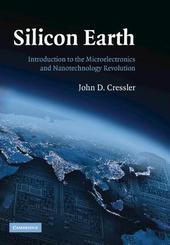
|
Silicon Earth: Introduction to the Microelectronics and Nanotechnology Revolution
Hardback
Main Details
| Title |
Silicon Earth: Introduction to the Microelectronics and Nanotechnology Revolution
|
| Authors and Contributors |
By (author) John D. Cressler
|
| Physical Properties |
| Format:Hardback | | Pages:508 | | Dimensions(mm): Height 260,Width 185 |
|
| Category/Genre | Nanotechnology
Electronics engineering |
|---|
| ISBN/Barcode |
9780521879392
|
| Classifications | Dewey:620.5 |
|---|
| Audience | | Tertiary Education (US: College) | | Professional & Vocational | | General | |
|---|
| Illustrations |
6 Tables, unspecified; 222 Halftones, unspecified; 176 Line drawings, unspecified
|
|
Publishing Details |
| Publisher |
Cambridge University Press
|
| Imprint |
Cambridge University Press
|
| Publication Date |
17 August 2009 |
| Publication Country |
United Kingdom
|
Description
We are in the swirling center of the most life-changing technological revolution the Earth has ever known. In only 60 years, an eye-blink of human history, a single technological invention has launched the proverbial thousand ships, producing the most sweeping and pervasive set of changes ever to wash over humankind; changes that are reshaping the very core of human existence, on a global scale, at a relentlessly accelerating pace. And we are just at the very beginning. Silicon Earth introduces readers with little or no background to the many marvels of microelectronics and nanotechnology, using easy, non-intimidating language, with an intuitive approach using minimal math. The general scientific and engineering underpinnings of microelectronics and nanotechnology are addressed, as well as how this new technological revolution is transforming a broad array of interdisciplinary fields, and civilization as a whole. Special 'widget deconstruction' chapters address the inner workings of ubiquitous micro/nano-enabled pieces of technology such as cell phones, flash drives, GPS, DVDs, and digital cameras.
Author Biography
John D. Cressler is the Ken Byers Professor of Electrical and Computer Engineering at the Georgia Institute of Technology. He received his Ph.D. in Applied Physics from Columbia University in 1990. After working on the research staff at the IBM Thomas J. Watson Research Center for eight years, he began his academic career at Auburn University in 1992 and then joined the faculty at Georgia Tech in 2002. His research interests center on developing blindingly fast, next-generation electronic components using silicon-based heterostructure devices and circuits. He and his research team have published over 450 scientific papers in this area. He has served as associate editor for three IEEE journals and on numerous conference program committees. He is a Fellow of the IEEE and was awarded the C. Holmes MacDonald National Outstanding Teacher Award (Eta Kappa Nu, 1996), the IEEE Third Millennium Medal (2000), the Office of Naval Research Young Investigator Award (1994), the Birdsong Merit Teaching Award (1998), and the Outstanding Faculty Leadership for the Development of Graduate Research Assistants Award (2007). His previous books include Silicon-Germanium Heterojunction Bipolar Transistors (2003), Reinventing Teenagers: The Gentle Art of Instilling Character in Our Young People (2004), and Silicon Heterostructure Handbook: Materials, Fabrication, Devices, Circuits, and Applications of SiGe and Si Strained-Layer Epitaxy (2006).
Reviews"In this unique book, Cressler, displaying his immense and diverse knowledge, demystifies the overwhelming concepts of microelectronics..Recommended." - CHOICE "take you through a historical voyage to the modern wonders of electronics and nanotechnology... provides a concise, easy to follow, step-by-step discussion of the evolutionary history of silicon-based electronics, microelectromechanical structures (MEMS), and nanotechnology, as well as their impact on our live...topic coverage in this book is quite remarkable...This book is a comprehensive yet thrilling and invigorating simple-to-read text that is well on its way to becoming a classic." - Mohammad Mojarradi and Benjamin Blalock, IEEE Nanotechnology, September 2010
|